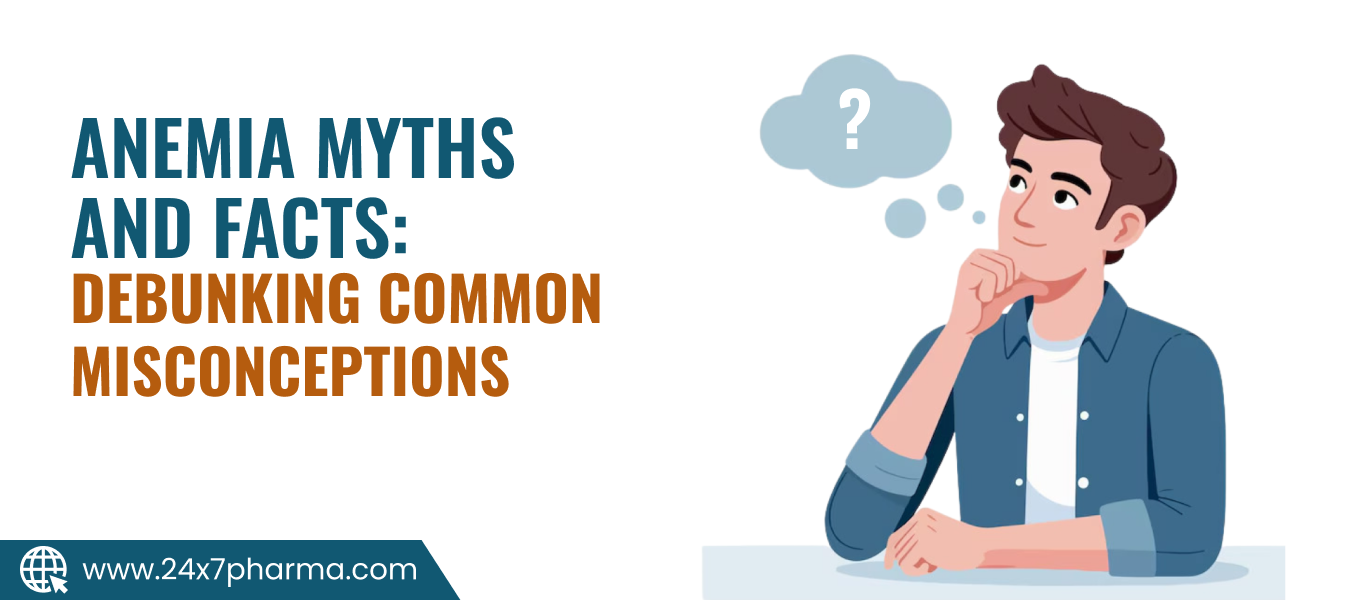Anemia is a common health condition that affects millions of people worldwide, yet it remains widely misunderstood. Many myths surrounding anemia lead to misinformation, delaying proper diagnosis and treatment. Understanding the facts is crucial to managing and preventing this condition effectively. In this article, we will debunk some of the most common misconceptions about anemia and shed light on the truth behind them.
What is Anemia? Understanding the Basics
Anemia occurs when the body lacks enough healthy red blood cells or hemoglobin to carry sufficient oxygen to tissues and organs. This can result in fatigue, weakness, dizziness, and other symptoms.
There are several types of anemia, including:
- Iron-deficiency anemia – the most common type, caused by a lack of iron in the diet or poor absorption.
- Vitamin B12 and folate deficiency anemia – occurs when the body doesn’t get enough of these essential vitamins.
- Aplastic anemia – a rare but serious condition where the bone marrow fails to produce enough blood cells.
- Hemolytic anemia – occurs when red blood cells are destroyed faster than they are produced.
- Sickle cell anemia – a genetic disorder causing abnormal red blood cell shapes that hinder oxygen transport.
Now that we understand anemia, let’s break down some of the most common myths associated with it.
Myth vs. Fact: Unraveling the Truth About Anemia
Myth 1: Anemia Only Affects Women
Fact: While women are at higher risk due to menstruation, pregnancy, and childbirth, anemia can affect men, children, and older adults. Nutritional deficiencies, chronic diseases, and genetic conditions also contribute to anemia in all genders and age groups.
Myth 2: Anemia is Just a Mild Condition
Fact: Anemia is not just about feeling tired. If left untreated, severe it can lead to serious health complications, including heart problems, pregnancy-related issues, and developmental delays in children. Chronic anemia can also weaken the immune system, making the body more susceptible to infections.
Myth 3: Eating More Red Meat is the Only Cure
Fact: While red meat is a good source of heme iron (easily absorbed iron), it is not the only solution. Leafy greens, legumes, nuts, seeds, and fortified cereals are excellent non-heme iron sources. Additionally, consuming vitamin C-rich foods like oranges, bell peppers, and tomatoes enhances iron absorption. People following vegetarian or vegan diets can maintain adequate iron levels with a balanced diet and proper food combinations.
Myth 4: Anemia is Always Caused by Iron Deficiency
Fact: Iron deficiency is just one cause of anemia. Other causes include vitamin B12 and folate deficiencies, chronic diseases (such as kidney disease and cancer), and inherited conditions like sickle cell anemia and thalassemia. Proper diagnosis through blood tests is essential to determine the underlying cause.
Myth 5: Drinking Tea and Coffee Doesn’t Affect Iron Absorption
Fact: Many people don’t realize that tea and coffee contain tannins, which can inhibit iron absorption. Drinking these beverages with meals can reduce the body’s ability to absorb non-heme iron from plant-based foods. It’s best to consume tea and coffee between meals rather than during them, especially for individuals at risk of anemia.
Myth 6: Only Fatigue Indicates Anemia
Fact: While fatigue is a common symptom, anemia can also cause dizziness, shortness of breath, pale skin, irregular heartbeat, headaches, cold hands and feet, and difficulty concentrating. Some forms of anemia may also cause brittle nails and unusual cravings for non-food items like ice or clay (a condition known as pica).
How to Prevent and Manage Anemia Effectively
1. Maintain a Balanced Diet
Eating a well-balanced diet rich in iron, vitamin B12, folate, and vitamin C helps prevent and manage. Some essential foods include:
- Iron-rich foods: Spinach, lentils, lean meats, quinoa, tofu, and shellfish.
- Vitamin B12 sources: Eggs, dairy products, fish, and fortified plant-based alternatives.
- Folate-rich foods: Leafy greens, beans, avocados, and citrus fruits.
- Vitamin C sources: Oranges, strawberries, kiwi, bell peppers, and tomatoes.
2. Consider Iron Supplements (If Necessary)
For individuals with diagnosed iron deficiency anemia, doctors may recommend iron supplements. However, self-medicating with iron pills can lead to digestive issues and toxicity. Always consult a healthcare professional before taking any supplements.
3. Regular Health Check-Ups
Routine blood tests help detect anemia early. If you experience symptoms of anemia, seek medical advice to identify the cause and receive appropriate treatment.
4. Address Underlying Health Conditions
Chronic illnesses, infections, and gastrointestinal disorders like celiac disease can interfere with nutrient absorption and contribute to disease. Managing these conditions can improve overall health and prevent it from worsening.
Read More : Anemia: Types, Symptoms, and Risk Factors
Recognizing When Medical Attention is Needed
If you frequently experience extreme fatigue, lightheadedness, pale skin, irregular heartbeat, or shortness of breath, you should consult a healthcare provider. The symptoms can be mistaken for other conditions, so a thorough medical examination, including blood tests such as a complete blood count (CBC) and iron levels, is crucial. Early diagnosis ensures timely treatment and helps prevent complications.

